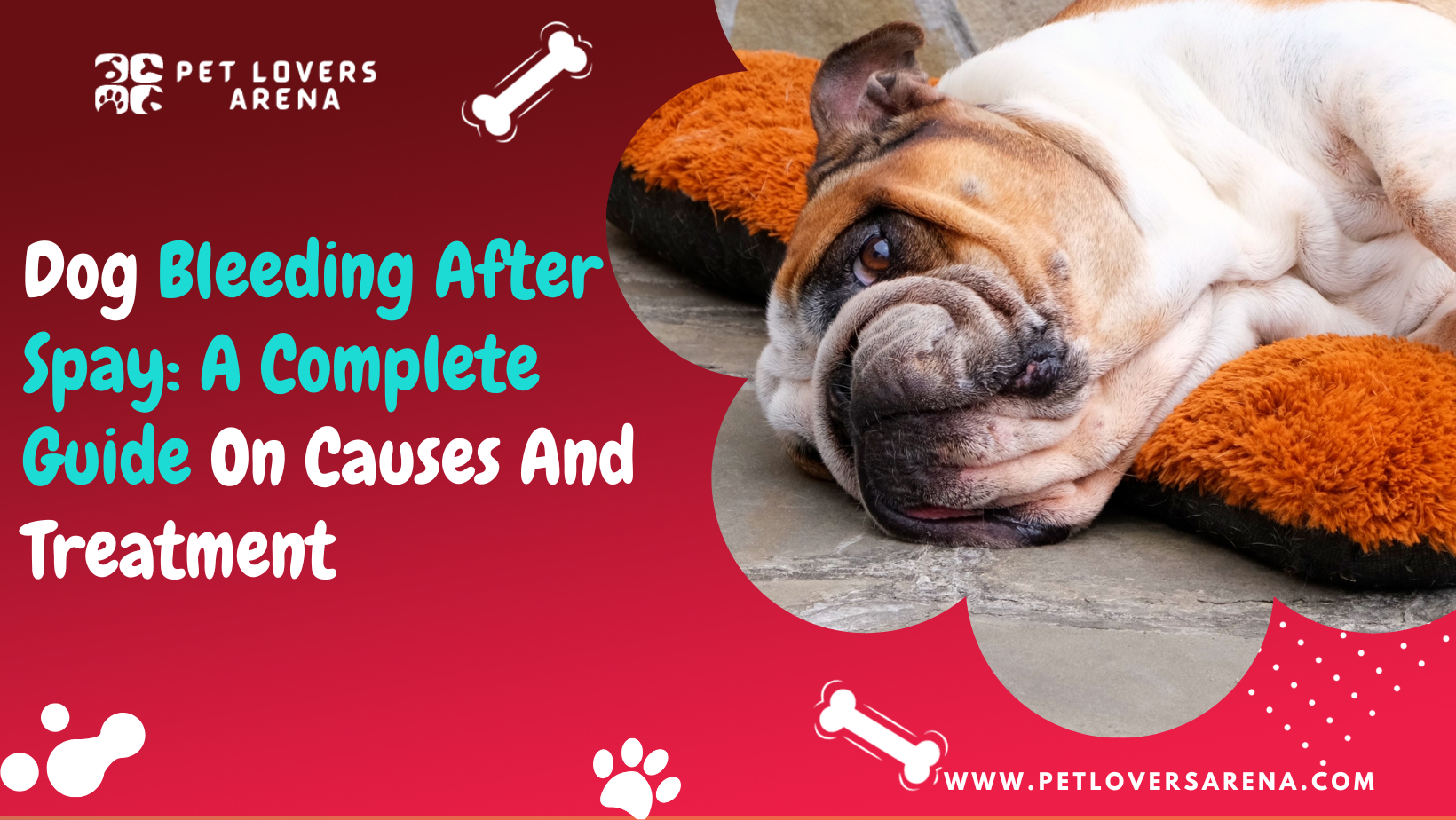Safely sterilizing the dog has always been an issue for the caregiver. No matter how less sterilization you perform on your dog, there will always be some problems related to it that you will probably notice in a day or two. Spaying may have negative effects on the dog, and you shouldn’t ignore such symptoms that indicate the negative effects of sterilization on dogs.
You may notice bleeding after the dog returns from spaying. There can be many reasons for your dog’s bleeding from the spaying incision after the spaying surgery is performed. While cases of bleeding in dogs after sterilization are rare, it is still possible. The article will provide you with knowledge about why the dog bleeds after spaying or sterilization.
What Does it Mean to Spay a Dog?
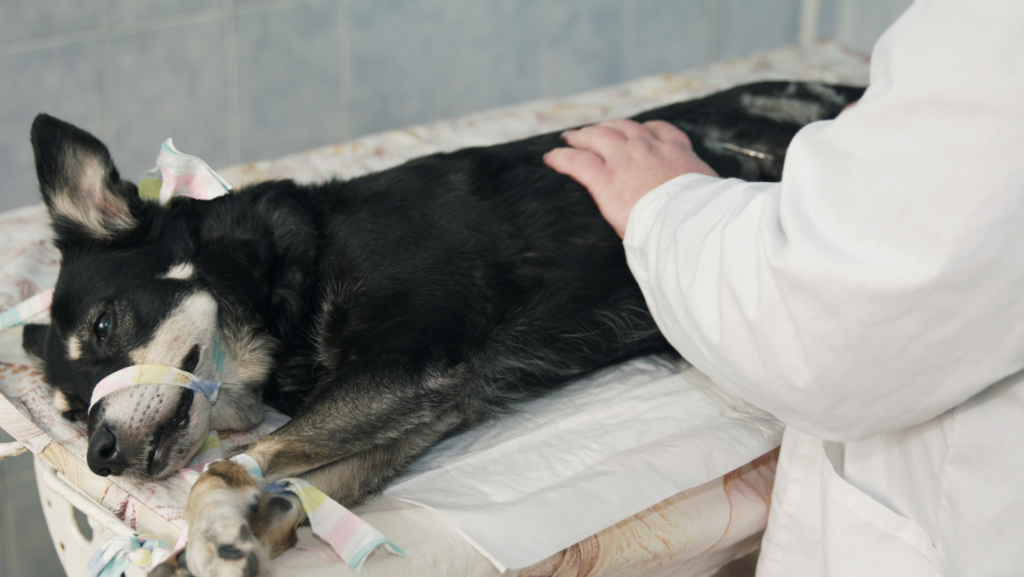
Before we talk about bleeding after spaying, we need to know what spaying is. Spaying is a sterilization method, as we have already discussed, but to understand it well, we need to know about sterilization in males and females separately. So here, you will get to know about both sterilizations separately of male and female dogs.
Sterilization for Male Dogs: Sterilization in males is simpler than in females because male genital organs are only present outside. For the reasons stated above, castration performed on a male dog is much faster than on a female dog.
In castration in males, the veterinarian makes an incision at the base of the penis of the dog and removes the testicle. After extracting the testicle, the incision gets closed again by stitches that are either visible or not visible. Later on, these stitches get removed.
Sterilization of Female Dogs: Sterilization of a female dog or a bitch is a more complicated process than that of a male dog. For sterilization or spaying in females, an incision is made in the abdomen to extract the ovaries and uterus. The ovaries and uterus in female dogs get arranged in a Y-shaped structure. The different layers were sutured internally and externally and then closed using staples.
After both spaying and castration, it is important to seal the wound to protect it. You must be careful that the wound is always covered, as the wound needs protection from the dog’s biting or scratching.
For protecting the wound, the veterinarian often recommends the use of E-collars. Keeping the wound clean is also important for quick healing, and you will need a veterinarian’s assistance.
Read More: 7 Best Shock Collar For Large Dogs
How Are Dogs Spayed?
Spaying aims to achieve sterilization in female dogs, and this process can be performed in many ways.
Ovariohysterectomy is the most common method of spaying in female dogs. Here the ovaries and uterus are removed. However, some veterinarians prefer to perform ovariectomy, where only the ovaries and uterus parts closely related to the ovaries get removed instead of the whole uterus. Let’s find out about both the procedures in a bit more detail.
Ovariohysterectomy is the process that involves the removal of both the uterus and ovaries of the female dogs for sterilization. In this procedure, the veterinarian makes an incision on the underside of the belly of the bitch. The incision can be either large or small, and from the incision, the ovaries and uterus get removed from the dog’s body, and the stitches are internal mostly.
The large blood vessels must get closed off before the stitches. In addition, the internal stitches must be dissolvable so that the stitches do not need to get removed after some time and get dissolved on their own. The veterinarian may also put some stitches on the skin of your dog to have these stitches removed, but 10 to 14 days after the surgery.
Ovariectomy: Instead of removing the whole uterus, only a part of the uterus closely related to the ovaries gets removed along with the ovaries.
Similarly, like in ovariohysterectomy, in ovariectomy, the incisions are made on the underside of the belly of the dog. Again, the veterinarian can do this procedure using a laparoscope. However, laparoscopic surgery requires specialized training, and in this procedure, numerous small incisions are made in the belly of the bitch.
Ovariectomy is not as common as ovariohysterectomy, but this method can be used as a sterilization technique in female dogs. In addition, ovariectomy can reduce the risk of ovarian and mammary cancer in female dogs.
What Are the Complications After Spaying Surgery?
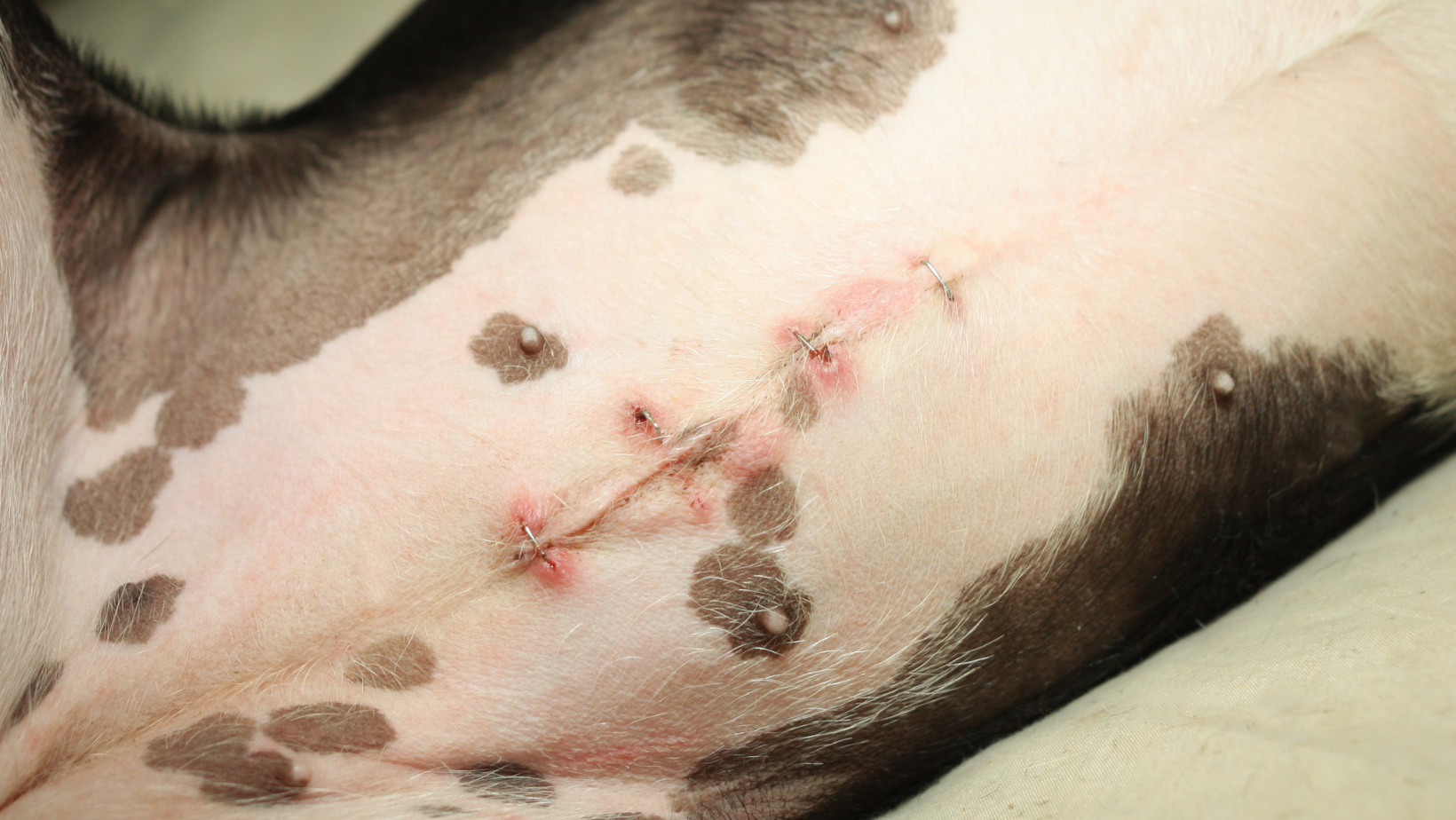
It is understandable if you get worried after noticing your dog bleeding after spaying surgery. However, in addition to bleeding, your dog may experience several other complications following spaying surgery. To ensure your dog is not facing any difficulty, it is important that you closely monitor your dog after spaying surgery. Here are some very normal symptoms after spaying surgery on your dog.
Dog Drooling After Taking Anesthesia: After taking anesthesia, the dog loses control of its muscle movement, so to notice excessive drooling in your dog is normal.
Dog Panting Heavily After Spaying Surgery: You may notice the dog panting heavily after the surgery or spaying, which could be a possible side effect of the surgery. The veterinarian will often prescribe your dog some pain relief medicine to cure heavy panting.
Dog Crying and Wailing After Anesthesia: You may notice it crying or whimpering when the dog comes out of anesthesia. This crying and whimpering can be a result of discomfort. For example, the dog may cry due to disorientation by anesthesia or discomfort caused to your dog due to stitches. Another reason could be that your dog is hungry from not getting fed for a long time, but you should give them a simple meal in a small amount to your dog. Don’t overfeed it.
Dogs May get Disoriented After Surgery or Spaying: In addition, before the surgery, the dog receives a lot of drugs and anesthesia, so, commonly, your dog faces issues in getting many things and seems utterly confused.
These symptoms may persist in your dog for several hours after surgery. However, if the symptoms persist for more than a day, contact your veterinarian to discuss the situation and rule out any complications.
Is it Normal That a Dog is Bleeding After Spaying?
While performing the surgery, if spayed, the ovaries and uterus get removed, and in this process, an incision is made on the dog’s body. It is normal for these incisions to bleed during an intervention, and the veterinarian normally controls this bleeding.
The other reason for bleeding can be the dog’s drugs used during surgery. During the surgery, the dog gets some anesthesia drugs, which suppress your dog’s blood pressure. Once the dog gains consciousness, it is normal for bleeding to occur due to increased blood pressure, but remember that the bleeding should not be excessive.
Once the surgery is performed on your dog, the postoperative phase starts. In this postoperative phase, due to invasive techniques and the incisions used at the surgery, there can be a red or purple area near the incision. This condition in which the red and purple areas are known as a hematoma, which is somewhat normal.
However, if you notice that the whole stomach of your dog is red or purple, it may indicate internal bleeding. And when you notice the whole stomach of your dog turning red or purple, you should seek help from the vet.
You may also notice that the wound gets swollen, and there is profuse bleeding from the wound, but this bleeding will remain for a while only and will stop soon. The main reason for this bleeding can be falling off a stitch that may have failed to cover up the wound.
You May Also Read: Why Does My Puppy Have Loose Stools At Night?
Should You Get Worried if You Notice Your Dog Bleeding After Spaying?
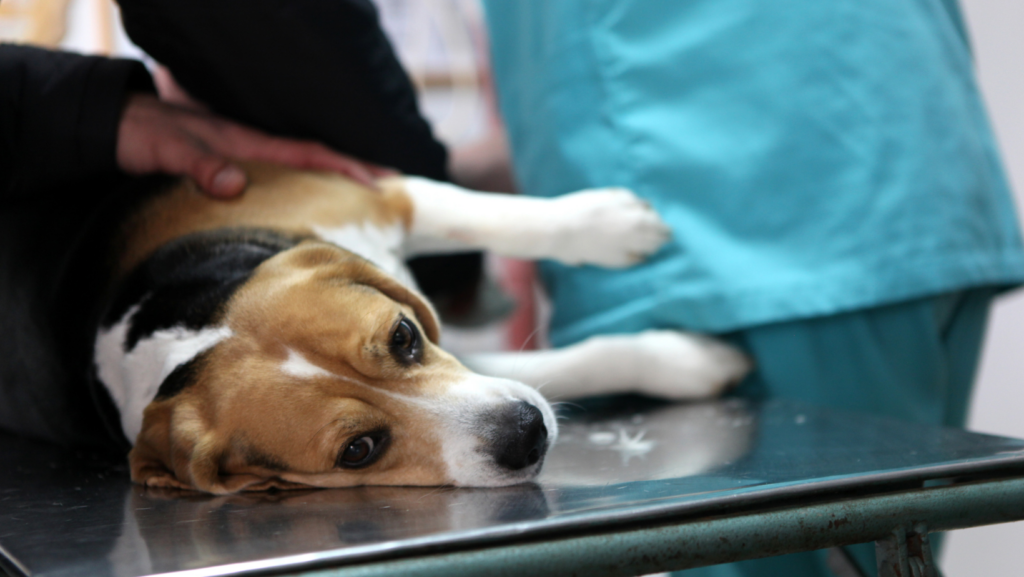
A bit of bleeding after the spaying process is normal, but if you notice that the dog is bleeding excessively, you need to worry. To know your dog’s safety, it is important that you first check the amount of blood that the dog is bleeding out. Along with noticing other symptoms, this is also important.
It is strictly recommendable to take immediate action if you notice the following two conditions.
There is bleeding from an external point due to the fall of the incision or of an external problem after surgery. In such a case, the veterinarian will restore the whole wound. Taking an expert’s advice to treat an open wound is extremely important. Otherwise, some infections or organ prolapse from the incision is also possible.
In the other instance, bleeding in dogs after spaying can also be internal, and you may notice that the dog turns pale. You can also observe the temperature of your dog’s body falling rapidly. If there is internal bleeding after spaying, the veterinarian or professional help is a must.
If, after spaying, the bruises and incisions are not painful, go away, and are not bleeding, then there is nothing to worry about. However, if you notice that your dog is bleeding excessively and the bruises are painful all over the abdomen, it may be serious. Therefore, to clear your doubts and help your dog, immediate consultation with the veterinarian about the same is highly recommendable.
My Dog is Bleeding After Spay Treatment
If you notice that your female dog is bleeding excessively after the spaying treatment, you need to check with the veterinarian about the reason behind it. The veterinarian can check the site of the incision and can tell you the reason for this bleeding in your dog.
Under no circumstances should you try the treatment for the bleeding after spaying surgery on your own at home. In case any surgery is necessary for this treatment of bleeding, the vet will know it well. He will perform the surgery in a sterile environment with the right instruments you can never do.
Besides this, it is extremely normal if your dog feels pain after the spaying treatment. Still, you should never give pain medications to your dog unless and until the dog’s veterinarian recommends it.
The dog veterinarian very well knows the amount of medication your dog requires. Giving excess dosage may cause harm to your dog, so be careful. Also, don’t try to give your dog any other human pain relief medications, as it may be very dangerous for your dog.
Treatment For Bleeding in Dogs After Spaying
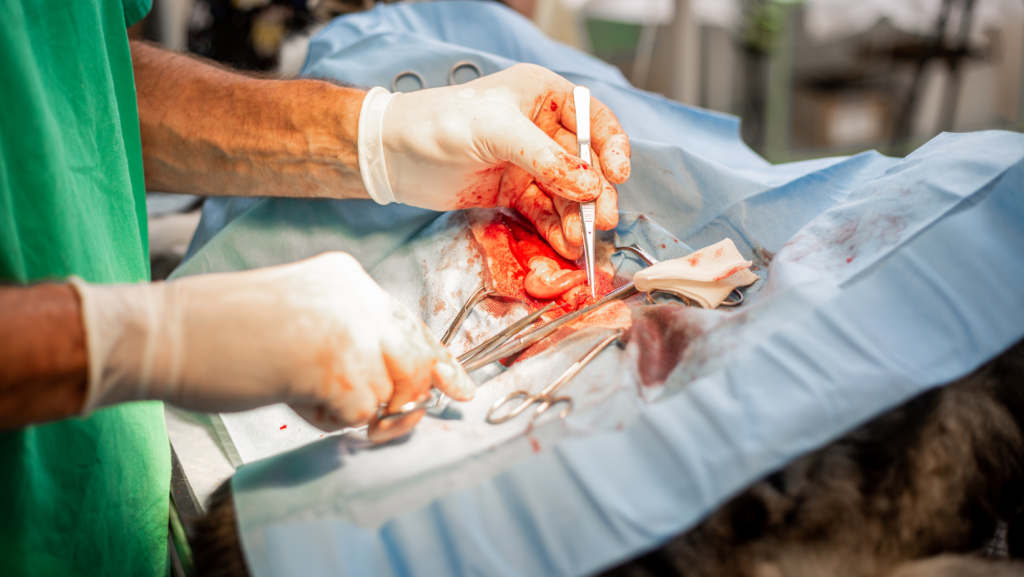
The surgery will be there if your veterinarian recommends additional surgery after examining your dog. The surgery will focus on treating the cause of the bleeding. It can be to suture the sutures that have fallen and caused bleeding or treat internal bleeding or other internal complications in your dog. After that, the veterinarian may suggest some antibiotics to treat and recover your dog.
Make sure your dog takes the medications on time.
Other issues you may notice as a result of complications such as sterilization or spaying performed on your dog can be many. Be aware of any unusual symptoms and consult a veterinarian if you notice anything unusual.
Why Does the Dog Start Bleeding From the Vulva After Spaying Surgery?
Your dog will show many symptoms when it is bleeding after being spayed. Bleeding after spaying for female dogs is not normal, but their heat cycle can be more than normal.
Suppose your dog keeps bleeding after surgery or spaying. In that case, you need to contact the veterinarian as soon as possible as there are high chances that the dog may be suffering from ovarian remnant syndrome.
Ovarian remnant syndrome means that in your female dog, not all the ovarian tissue gets removed in ovariectomy surgery. These remnant ovarian tissues can release many hormones and trick the female dog into thinking it is heated. Also, if your dog gets spayed in heat or a day or two before the heat, there are possible reasons to release blood through the vulva.
If any other dog is suffering from bleeding from the vulva, it can be due to a urinary infection. Besides this, female dogs who have had spay surgery recently are prone to urinary tract infections. Therefore, it is possible that the bleeding you notice is not from the vulva of the dog but its urinary tract.
If you notice that your pet dog is suffering from a UTI, it is highly recommendable that you visit the veterinarian for your dog’s checkup. If the urinary tract infections in females remain untreated, it may cause several problems, like kidney infections in dogs.
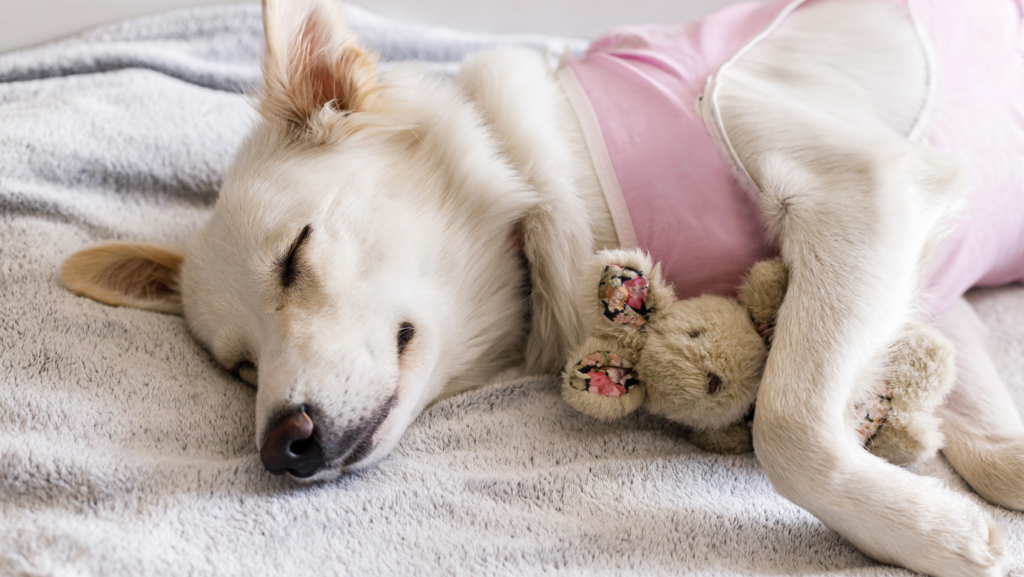
How to Assist Your Dog’s Recovery After Spay Surgery?
If you notice your dog bleeding or refusing food after spaying, immediately consult a veterinarian. You may also need to consult a vet if you observe vomiting, having diarrhea, looking pale, changing the color of your dog’s gums, sluggishness, and decreasing breathing rate. In the following ways, you can help your dog recover after spay surgery.
Also Read: My Dog Threw Up Hard White Chunks – Should I Be Worried?
1. Use an e-collar on your dog
Licking the incision area of your dog can lead to many infections. Therefore, the veterinarian suggests making your dog wear an e-collar. Wearing an e-collar will prevent premature removal of stitches and infections caused by licking of the area by the dog.
2. Restrict the activity of your dog for 10 to 14 days
No matter what type of surgery gets performed on your dog, you need to limit the movement of the female dog. It is 10 to 14 days the restricted activity or prohibition in the dogs. The veterinarian may extend the time, considering the condition of the incisions on your dog. Now it is important to let your dog out on a leash; after that, you can return to your normal walking schedule.
3. Check on the spayed incision of your dog regularly
You must check the incisions of your dog for any cuts or openings. Any opening in the incision may lead to a medical emergency, and you may need to contact the veterinarian immediately. Likewise, check if there are any loose stitches and consult the vet.
Besides this, check for any redness or swelling near the spaying area of your bitch.
Checking for internal hemorrhage or bleeding is critical if internal incisions are present. The internal incisions may fall off in the dog that the vet placed at the time of surgery. It can cause internal bleeding. Internal bleeding can be due to letting your dog run or return to its routine shortly after the surgery. In the event of an internal hemorrhage, consult the vet immediately.
4. Follow the instructions of Vet
You must follow the vet’s advice if you want your dog to recover quickly after spaying. Follow the expert’s advice not only for feeding or walking but for all the other activities for some time also.
5. It’s important to monitor the bathroom habits of your dog
You need to keep a check on the bathroom habits of your dog after spraying. Ask the vet if the dog has pooped or urinated after surgery and take her home. You have to monitor if the dog doesn’t poop or pee within 24 hours. It may require immediate veterinarian help.
6. Give the prescribed medicine to your dog
It is normal for the dog to experience pain after the surgery. But you gave only the prescribed medicines to the dog, which may not cause trouble and harm your dog’s health and recovery.
Conclusion
Spaying is a process of sterilization in female dogs, and bleeding after spaying is just normal. A bit of bleeding can be normal to some extent, but if that exceeds, the surgery has some complications.
In this article, we tried to provide you with all the information about the spaying of a dog; dog bleeding after spaying; the way your dog can recover after spaying surgery, etc. Make sure you follow the veterinarian’s advice and perform any experiments. Keep the dog’s mouth covered as it’s very important and let the dog not lick the area, causing more infections.
Meet Madison Phillips, your compassionate guide to pet well-being. With experience from VCA Animal Hospitals and Laxton Vet Clinics Bellaire Inc. Madison honed her skills and embraced the balance of medical expertise and compassion, through her articles, she simplifies pet care, whether you’re a newbie or an experienced pet parent.

